Snakeheads are a group of freshwater fish belonging to the family Channidae, part of the order Anabantiformes. These fish are named for their distinctive head shape and scale patterns that resemble those of a snake. Currently, there are two known genera: Parachanna, found primarily in equatorial Africa, and Channa, which inhabits South, Southeast, and East Asia. Some species from the Channa genus have also been introduced into North America, where they can pose ecological risks due to their predatory nature and adaptability.
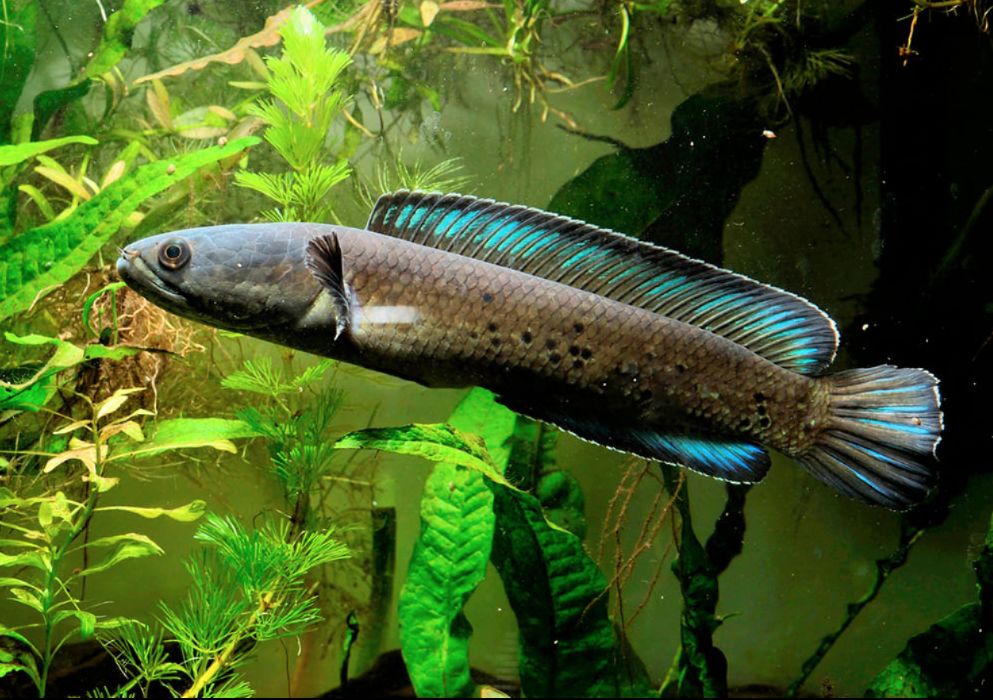
Contents
Habitat in the wild
The snakehead fish belongs to the family Channidae, a group of freshwater fish native primarily to Africa and Asia. Snakeheads have been introduced to other regions, including North America, where they are considered invasive species due to their ecological impact.
These fish are characterized by their elongated, snake-like appearance and adaptability to various habitats, including stagnant waters and low-oxygen environments. Some species can tolerate brief periods on land and are known to “walk” short distances using their pectoral fins.
Originally classified under the genus Ophicephalus, snakeheads were later divided into two distinct genera: Channa and Parachanna. The genus Channa, which includes 36 recognized species, comprises Asian snakeheads, while Parachanna contains only three African species. Additionally, various geographical morphs and some undefined species exist.
The name “Channa” is derived from the Latin word “channe,” a general term for ocean perch. In the wild, snakeheads can be found in diverse regions, from South-West India and West Afghanistan to East China, parts of Siberia, the island of Java, and across West Africa’s rivers, including the White Nile and the Congo.
Though widespread, little is known about their populations and habitats in the wild. They often thrive in boggy areas of rivers, lakes, and paddy fields, typically in murky waters overgrown with vegetation. Snakeheads can dig into the wet substrate, allowing them to survive short dry spells. More commonly, they will relocate to better habitats by pushing off with their tails and rowing with their fins across flat, muddy land.
In some regions, larger species of snakehead fish are harvested for food. Their flesh, while coarse and low in fat, is valued for its culinary qualities. Snakeheads grow quickly and are relatively undemanding in their care, making them suitable for breeding in artificial ponds, where they are often fed frogs and their larvae. This adaptability allows them to thrive in conditions that may not support other fish species.
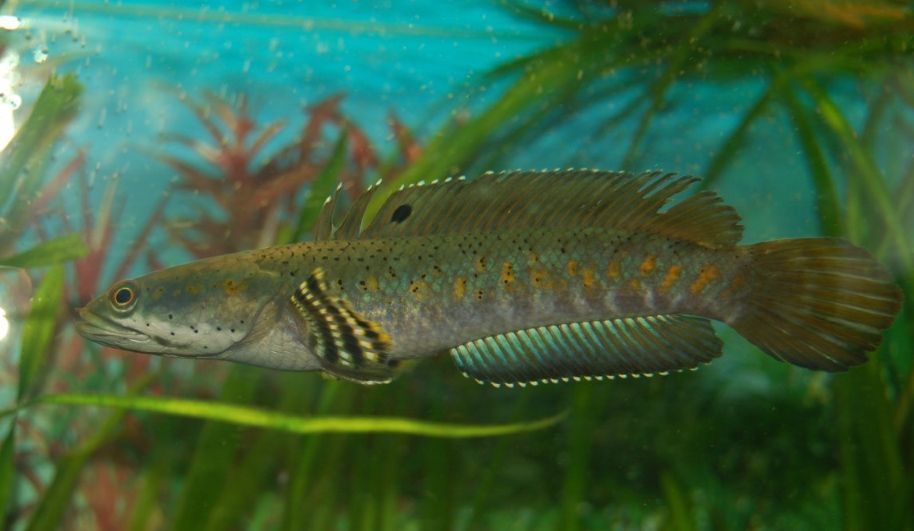
Description
Body Shape and Fins:
The elongated, fusiform body of snakehead fish is streamlined, allowing them to navigate through various aquatic environments efficiently. The dorsal and anal fins are indeed well-developed, extending nearly the entire length of the body, which aids in maneuverability. Their soft rays provide flexibility, making these fins effective for both propulsion and stability.
Head Structure:
The large, somewhat flattened head of snakeheads is a distinctive characteristic that aids in their predatory lifestyle. The scaly covering helps protect them from environmental hazards and predators. The numerous small setaceous teeth are ideal for grasping slippery prey, enhancing their hunting effectiveness.
Eyes and Gill Slits:
Although their eyes are not particularly large, they are well-adapted for low-light conditions, enabling snakeheads to hunt in murky waters. The prominent gill slits facilitate efficient respiration, particularly important in their often low-oxygen habitats.
Lateral Line System:
The lateral line system is crucial for detecting vibrations and movement in the water, allowing snakeheads to sense prey and avoid predators. The curvature of this line on the forebody enhances their ability to detect subtle changes in their environment, a key advantage for ambush hunting.
Survival Out of Water:
The remarkable ability of snakeheads to survive out of water for extended periods, particularly in humid conditions, showcases their adaptability. This adaptation allows them to migrate between water bodies during droughts or when seeking new habitats, which is critical for their survival and expansion.
Low Oxygen Tolerance:
Their unique respiratory adaptation, involving paired suprabranchial chambers, enables snakeheads to extract oxygen from the air. This physiological trait allows them to inhabit environments with low dissolved oxygen, giving them a competitive edge over other fish species that cannot tolerate such conditions.
Breathing Mechanisms:
Both adult snakeheads and juveniles have the capability to breathe atmospheric air, making them resilient in diverse aquatic environments. This ability is especially beneficial in stagnant or polluted waters, where oxygen levels can fluctuate dramatically.
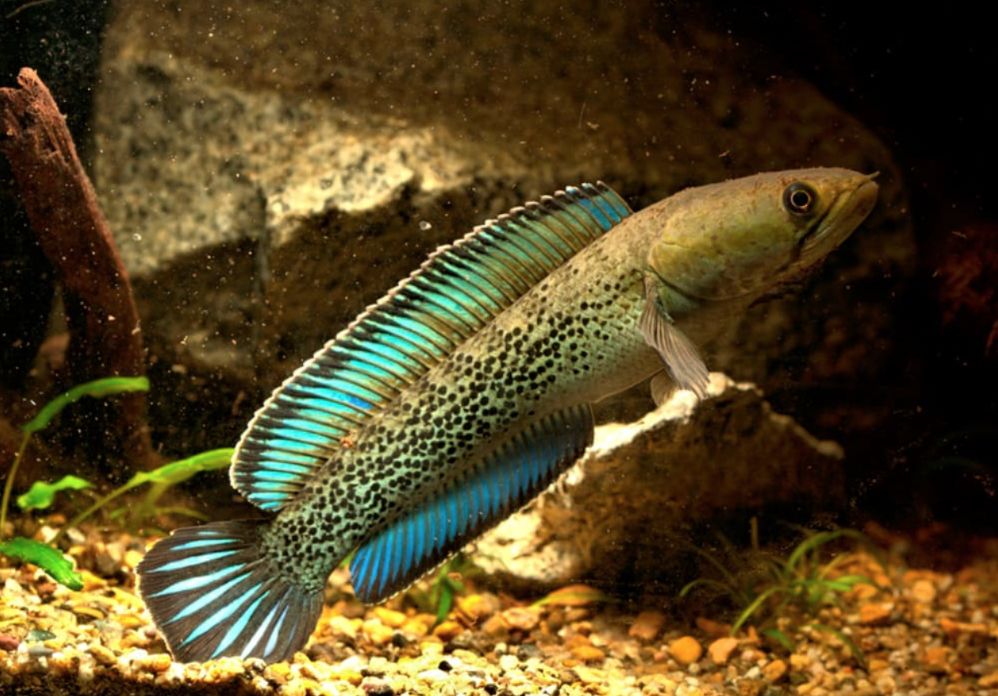
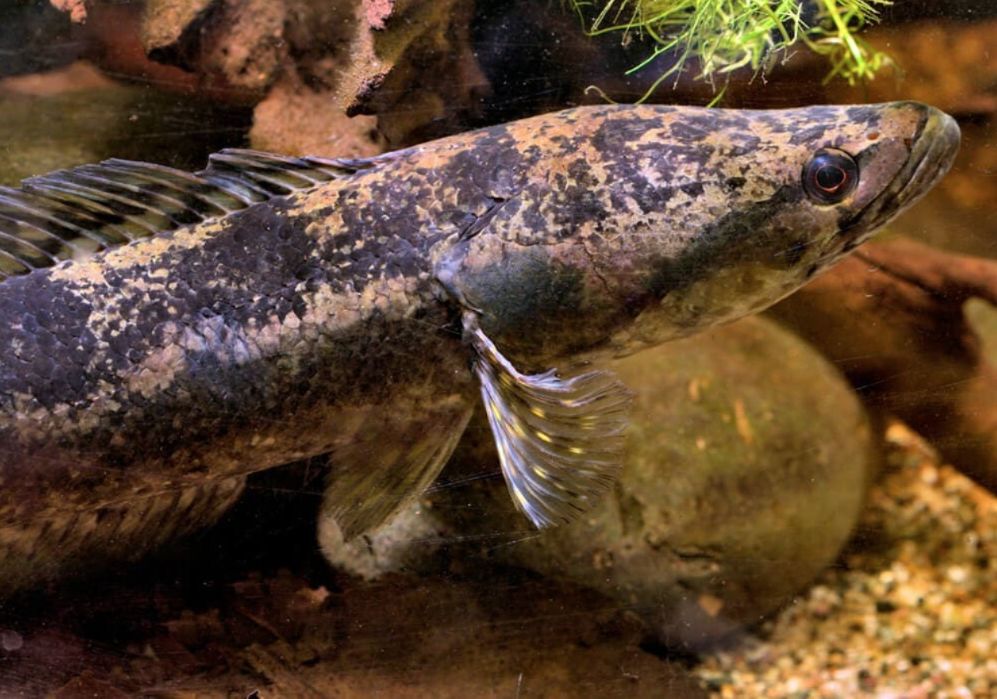
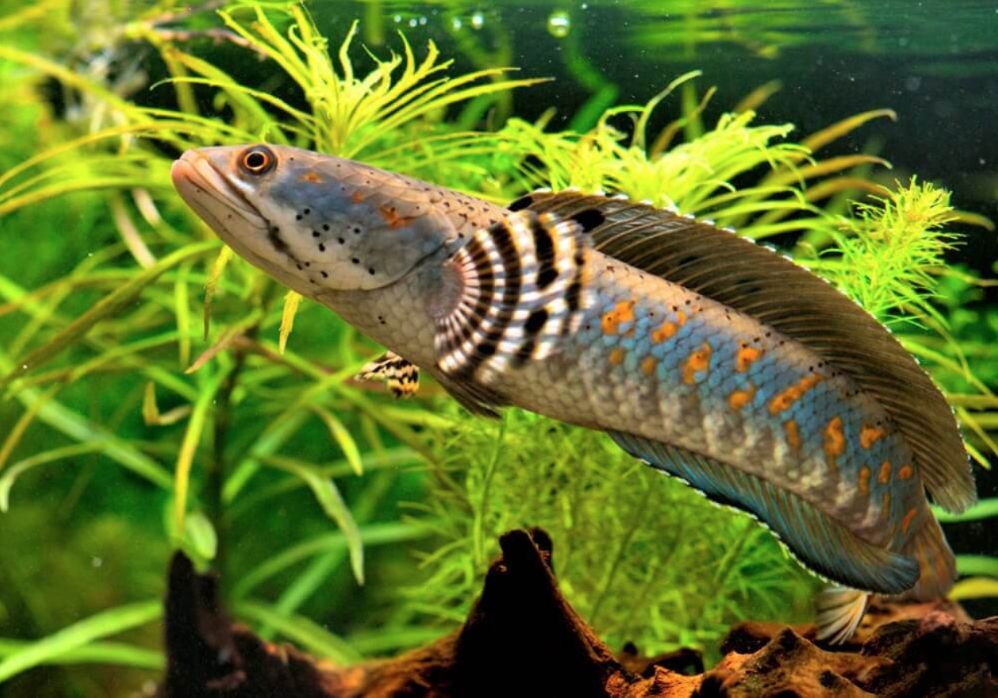
Difficulties in keeping
Overall, while snakeheads can be rewarding to keep, they are best suited for experienced aquarists who can accommodate their specific needs and manage their aggressive behavior effectively.
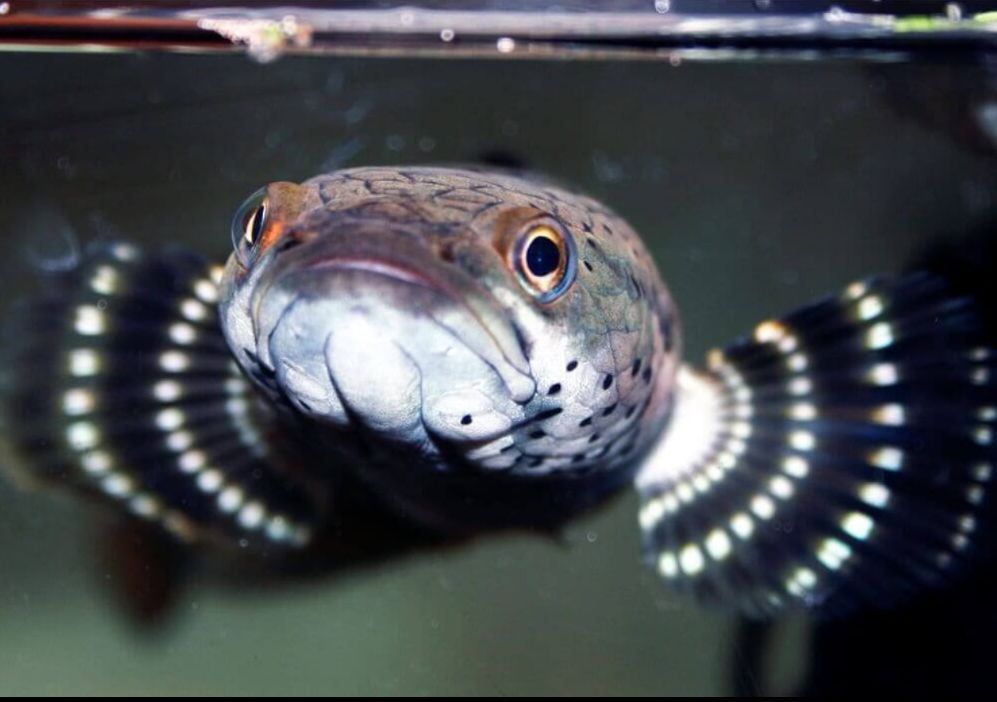
Keeping in a tank
Breathing Needs
To breathe, snakeheads, like climbing perch species, require continuous access to atmospheric air. It’s essential to leave a gap between the water’s surface and the tank cover. This allows the fish to gulp air, as they are equipped with specialized respiratory systems that enable them to extract oxygen directly from the air.
A common misconception among beginner aquarists is that fish capable of breathing atmospheric air can thrive in poor water quality. While snakeheads can endure challenging environmental conditions in the wild, this should not encourage neglect in tank care. Optimal water parameters are vital for their health and well-being.
Despite their resilience, it is crucial to maintain high water quality in captivity. Neglecting this can lead to stress and illness, even for species known for their hardiness. Regular water changes and monitoring of tank conditions are essential to ensure a stable environment.
Water Parameters
Most snakehead species prefer soft water, typically up to 8 GH, and slightly acidic conditions, with a pH range of 5.0 to 7.0. Creating a tank environment that mimics these natural conditions is recommended for optimal health and behavior.
Behavior in Captivity
In captivity, snakeheads may exhibit less activity compared to their wild counterparts. They tend to occupy the middle and bottom layers of the tank, surfacing occasionally for air. To accommodate this behavior, it’s beneficial to include shelters, such as driftwood, rocks, and aquatic plants, in the tank design.
In their natural habitat, snakeheads are wary of predators when they surface for air. This instinctual behavior prompts them to seek cover, such as floating plants, which should also be provided in the aquarium. Incorporating floating vegetation not only mimics their natural environment but also offers security and enrichment.
Predatory Nature and Tank Environment
As natural predators, snakeheads can make sudden, forceful movements that may disturb the substrate and cloud the water. To mitigate this, it is advisable to use small to medium-sized gravel as the tank bottom substrate rather than sand. This choice helps reduce substrate displacement and minimizes filter clogging.
Tank Covering
A tightly fitting cover glass or lid is essential for a snakehead tank. These fish are known for their propensity to jump, especially when startled or during feeding. A secure cover also helps maintain humidity levels and prevents accidental escapes, ensuring the safety and comfort of your snakeheads.
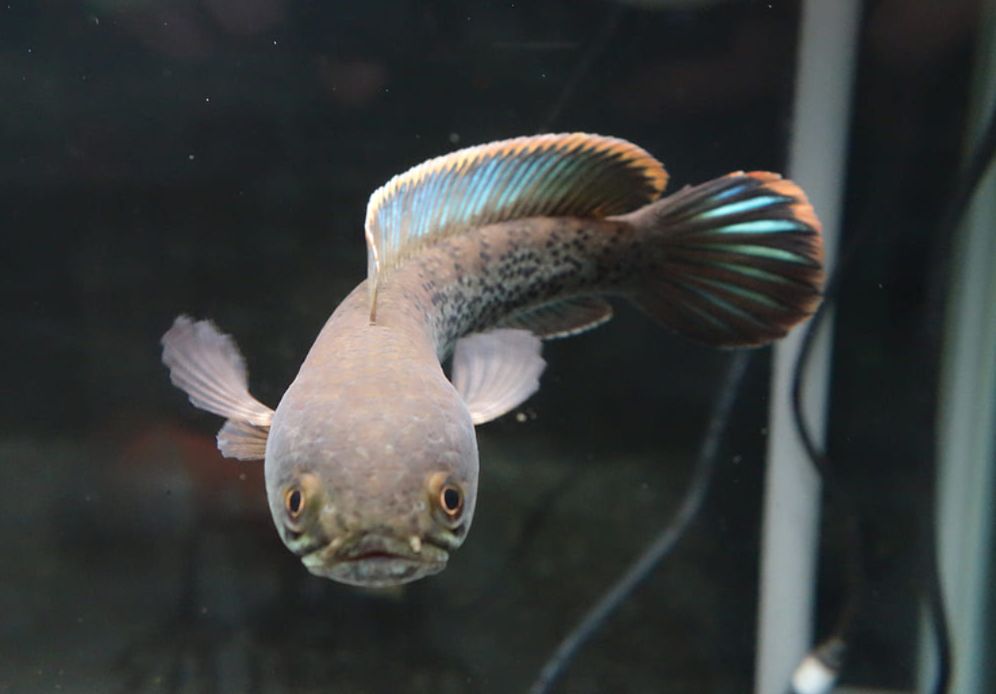
Diet
Unlike some fish that will readily consume food scattered across the water surface, snakeheads often benefit from targeted feeding approaches.
Feeding Techniques:
When feeding snakeheads, it’s effective to place food directly in front of them. Depending on the species and size of the fish, you can use your fingers or feeding pincers to present the food. This method mimics natural feeding behaviors, as snakeheads are ambush predators that rely on visual cues to locate prey.
Dietary Preferences:
Most snakehead species are omnivorous, but they thrive on a diet rich in protein. Insects and their larvae are particularly preferred. Offering live or frozen food such as crickets, mealworms, and earthworms will encourage healthy growth and vibrant coloration. These protein-rich foods not only provide essential nutrients but also stimulate natural hunting behaviors, which can be fascinating to observe.
Training to Accept Various Foods:
Snakeheads can be trained to accept a variety of foods, including meat, shellfish, and shrimp. This versatility allows aquarists to incorporate a broader range of dietary options. High-quality artificial foods, such as pellets or sticks specifically designed for carnivorous fish, can also be effective. These foods often contain a balanced mix of nutrients necessary for maintaining optimal health.
Feeding Schedule:
Establishing a regular feeding schedule is crucial. Young snakeheads may require feeding once or twice a day, while adults can typically be fed every other day. Monitoring their feeding habits will help you determine the right amount of food to prevent overfeeding, which can lead to poor water quality.
Advantages of Diet:
One of the notable advantages of snakeheads is their dietary habits; they do not consume tank plants or other vegetation. This characteristic allows aquarists to maintain a more diverse aquascape without worrying about plant destruction. Instead, you can focus on creating a visually appealing tank environment filled with various aquatic plants and structures for hiding and shelter.
Gender differences: male vs female
When it comes to identifying the sexes of snakehead fish, pronounced sexual dimorphism is generally absent. However, there are subtle physical differences that can help distinguish between males and females, though these features may not be easily observable to the untrained eye.
Typically, females exhibit a more rounded body shape compared to males. This difference is more pronounced, especially when females are preparing to spawn, as they may become noticeably fuller with eggs.
When viewed from above, adult males may have slightly wider heads than females. However, this distinction is subtle and often requires close observation. It’s important to note that this feature is not a reliable indicator of gender on its own.
While physical characteristics may be minimal, behavioral traits can sometimes provide clues. Males tend to be more aggressive and territorial, especially during breeding seasons. Observing interactions among the fish can help aquarists identify potential males through their more dominant behavior.
For aquarists interested in breeding snakehead fish, it’s beneficial to have a balanced ratio of males to females. This helps reduce aggression and allows for more successful spawning, as males will court females during mating rituals.
In summary, while snakehead fish do not exhibit pronounced sexual dimorphism, subtle differences in body shape and head width can assist in gender identification. Understanding these traits, alongside behavioral observations, can enhance breeding efforts and overall fish care in an aquarium setting.
Tank mates
Taking into account the predatory behavior most of this fish kinds are kept in tanks. Nevertheless, if you put some efforts into this you can successfully keep snakeheads in a community tank.
First of all, you should pay attention to the fish size. Most snakehead fish kinds will become good tank mates for other large sized fish species. Obviously, it’d be dangerous to keep together with tiny neon tetra or guppy fishes, since these tank mates will be treated by the fish as food.
It’s completely not an option to keep snakeheads with small catfish or loaches, since the fish won’t be able to swallow any of them and it’ll die from choking.
Active and undemanding fish kinds will do as tank mates for most most of average sized species. These can be large and medium sized carp, like KOI. Despite the predatory nature small sized snakeheads are timid and can be easily killed by large and aggressive cichlid (for example, flowerhorn).
Breeding
When provided with optimal tank conditions, snakehead fish breed relatively easily. However, the challenge lies in the inability to determine the gender of juveniles, which often leads aquarists to purchase multiple fish in hopes of forming breeding pairs. As the fish mature, they will begin to pair off and establish their own territories, isolating themselves from other tank mates.
Once a pair is formed, they become dedicated guardians of their territory. Some species breed spontaneously, while others may require environmental stimulation, such as a drop in temperature followed by a gradual increase, to mimic seasonal changes. In many cases, both parents participate in caring for their eggs and juveniles, which tend to stay close together in a school.
The parental care can be extensive, lasting until the young reach sizes of about 5 to 8 cm. Only after this growth do the parents encourage their offspring to disperse from their territory.
Intraspecific aggression is a notable behavior among snakeheads, especially when they are breeding. This makes it crucial to provide ample hiding spots in the tank, such as driftwood, large rocks, ceramic tubes, and dense plant foliage. Without sufficient cover, the fish may inflict serious harm on one another.
The most challenging period for aquarists begins when the fish reach reproductive maturity. During this time, aggression levels increase, and females often initiate fights. Unlike some other species, snakeheads do not engage in fin-nipping or mouth-locking behaviors. Instead, they tend to strike their rivals forcefully on the sides, which can leave white marks and exfoliated scales. In severe cases, these confrontations can lead to the death of one of the fish.